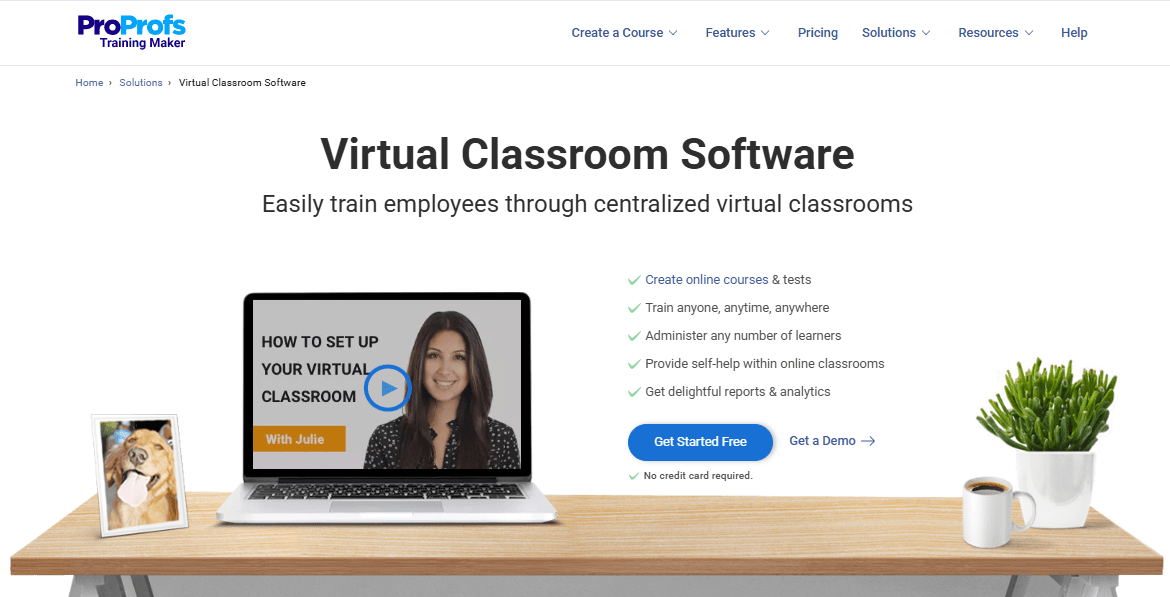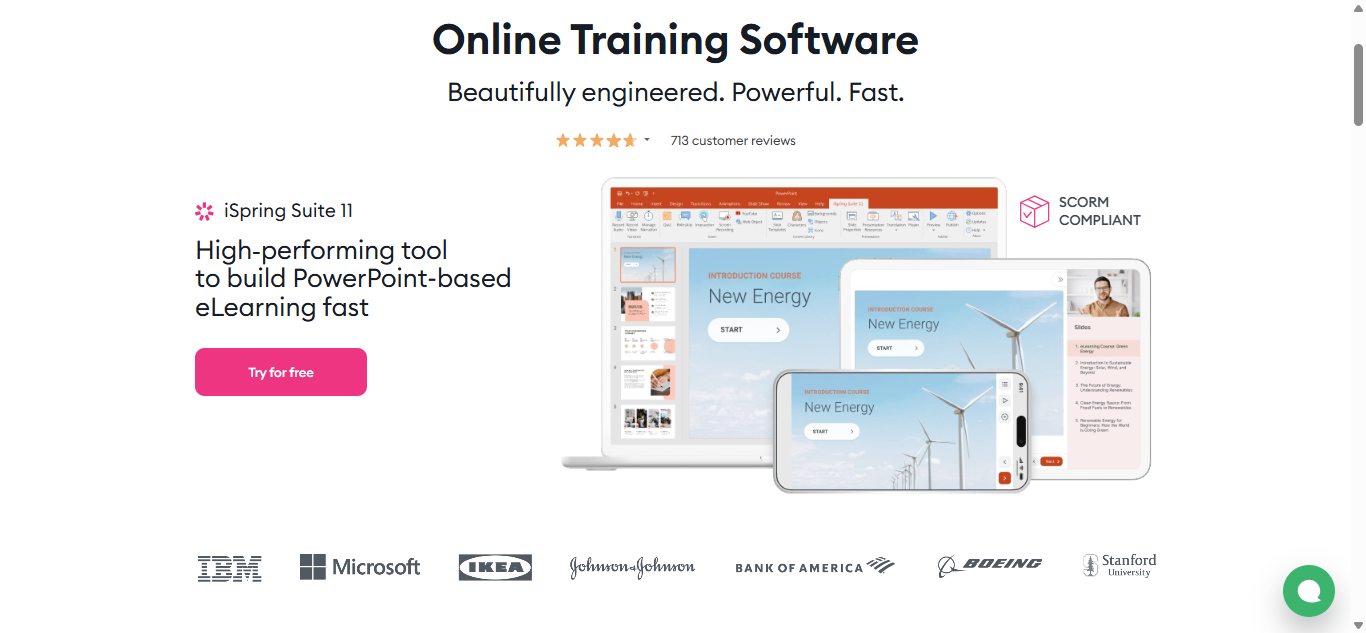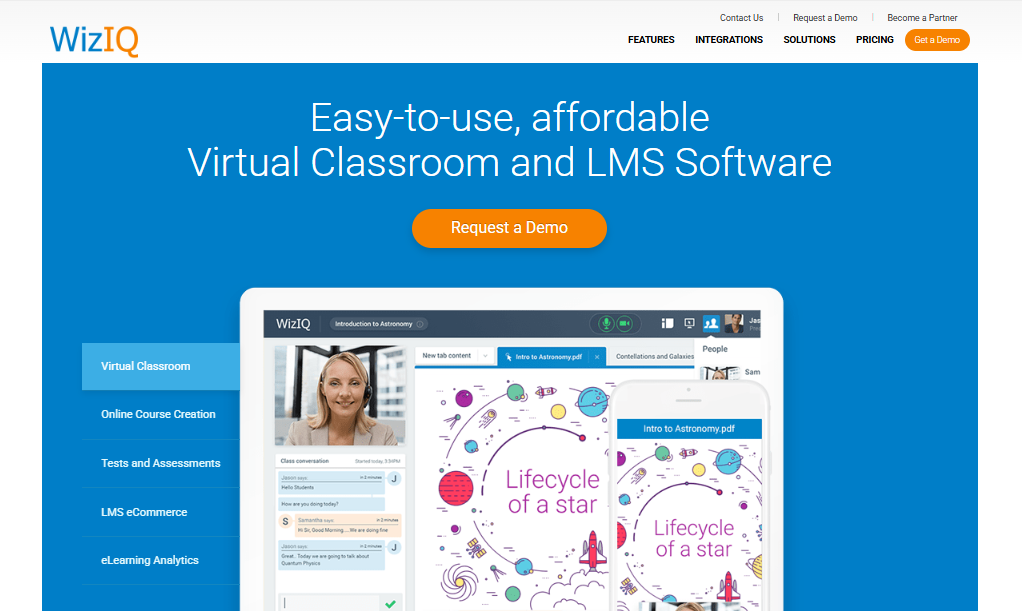I’ve been knee-deep in training tools for years, helping teams switch from clunky in-person sessions to something that actually works online.
The shift to virtual training isn’t just about throwing up a Zoom call and hoping it works. It’s about creating real-time learning experiences where instructors and learners connect live, bouncing ideas off each other, and engaging with polls, quizzes, and breakout chats.
The problem? Platforms that lag, crash, or scatter your training across a dozen different apps kill engagement faster than bad content ever could.
After digging through customer feedback and watching what works in the field, the pattern is clear:
- People want seamless integration with tools like Zoom or Google Meet.
- They need quick course setups.
- Instant feedback through embedded quizzes is a must.
- Everything should be unified in one spot, not scattered across multiple logins.
Here are my top picks for virtual instructor-led training software that deliver on those needs.
What Is Virtual Instructor-Led Training?
Virtual instructor-led training delivers live instruction through digital platforms, combining the human connection of traditional classroom training with the accessibility of online learning. Think real-time interaction, live Q&A, and immediate feedback, minus the conference room rental.
Unlike pre-recorded e-learning modules, VILT happens synchronously. An instructor teaches, learners participate, and everyone interacts in real time. It’s the difference between watching a cooking show and taking a live cooking class where the chef answers your questions as you burn the garlic.
Why it matters: VILT solves the engagement crisis plaguing asynchronous e-learning while eliminating the logistics nightmare and costs of in-person training.
Top 10 Best Virtual Instructor-Led Training Software
I’ve pulled this list from real user feedback and expert roundups, focusing on stability, engagement features, and value. Each one’s got a solid breakdown: what it does, key features in action, pros, cons, and pricing. Here’s a quick-scan table:
| Tool | Best For | Key Features | G2 Rating |
|---|---|---|---|
| ProProfs Training Maker | Startups and quick hybrid setups | Virtual classrooms, quizzes/polls, 50+ integrations, reports | 4.6/5 |
| Arlo | Training providers with scheduling needs | Course scheduling, Zoom integration, AI builder, e-commerce | 4.6/5 |
| iSpring Learn | Blended learning with custom paths | Interactive quizzes, role-plays, analytics, mobile app | 4.5/5 |
| Adobe Connect | Enterprise custom virtual rooms | HD video, whiteboards, breakout rooms, engagement dashboards | 4.3/5 |
| TalentLMS | Small teams with gamification | SCORM support, forums, AI builder, e-commerce | 4.5/5 |
| Docebo | Large teams with AI personalization | Content recommendations, automation, 400+ integrations | 4.3/5 |
| ReadyTech | Tech-heavy hands-on training | Virtual labs, co-browsing, instructor dashboards, and global support | 4.5/5 |
| BigBlueButton | Custom open-source setups | Whiteboards, breakout rooms, LMS integrations | 4.1/5 |
| LearnUpon | Personalized learner portals | Dashboards, forums, custom roles, reporting | 4.6/5 |
| WizIQ | Mobile-friendly corporate training | Virtual classrooms, course authoring, branded portals | 4.2/5 |
1. ProProfs Training Maker

ProProfs Training Maker unifies live virtual classrooms with on-demand courses, making hybrid training straightforward instead of scattered across multiple platforms.
What it does well: The virtual classroom in ProProfs combines hosting, AI course creation, quizzes, and tracking in one dashboard. It connects with Zoom, Google Meet, and Salesforce to deliver live, seamless training sessions. The AI Course Creator builds lessons in minutes, or you can pick from 500+ ready-to-use courses and templates for instant setup. Add gamified elements like points, badges, and leaderboards to keep learners engaged. Embed quizzes and polls during sessions for real-time interaction, then follow up with knowledge checks to reinforce learning. Advanced analytics reveal attendance, performance trends, and measurable ROI metrics that prove training impact.
Best for: Teams running blended learning programs who need both live and self-paced training without platform juggling or IT dependency.
Pros:
- Supports seamless hybrid training for both live and self-paced formats
- AI course creation accelerates content development and updates
- White labeling and gamification offer branded, interactive learning experiences
Cons:
- No downloadable or on-premise version
- Dark user interface option not available
Pricing: Free for up to 10 learners; Essentials at $1.99 per active learner/month (annual billing).
2. Arlo

Arlo handles the full training provider lifecycle, scheduling, registrations, payments, delivery, and reporting, with particular strength in monetizing courses.
What it does well: Virtual classroom integration with Zoom automates the logistics nightmare of reminders, registrations, and payments. The AI course builder speeds up content creation, while blended learning tools mix live sessions with e-learning modules. Reporting covers financial metrics like revenue and profit margins, making it easier to prove business impact to leadership. The e-commerce functionality works smoothly for selling course spots.
Best for: Training providers and mid-sized operations managing cohort-based programs who need end-to-end business management, not just training delivery.
Pros:
- Great for logistics like scheduling and e-commerce integration
- Smoothly supports blended learning formats
- Offers detailed analytics to measure business impact
Cons:
- Tailored more for mid-market use, it may overwhelm small teams
- Pricing details require a custom quote
Pricing: Mid-market focus with custom quotes; free trial available.
3. iSpring Learn

iSpring Learn delivers comprehensive LMS capabilities with strong VILT support, interactive simulations, and deep mobile learning features.
What it does well: Integration with Zoom and Microsoft Teams for live sessions, combined with role-play simulations for complex skill training. The mobile apps handle on-the-go access without feeling clunky, and white-labeling matches your brand identity. Analytics dig into skill gaps and quiz performance, giving you ammunition to justify training investment. Custom learning paths let you tailor experiences for different roles or skill levels.
Best for: Organizations prioritizing hands-on skill development through scenarios and simulations, especially teams needing mobile-first training.
Pros:
- Highly versatile for custom learning paths and branded experiences
- Strong mobile support for on-the-go learners
- Comprehensive reporting delivers measurable outcomes
Cons:
- Higher cost for small teams
- Some advanced features require a learning curve
Pricing: It starts at $3.75 per user/month for 500 users (annual billing), and a free trial is included.
4. Adobe Connect

Adobe Connect focuses on enterprise virtual classrooms with professional-grade customization and persistent learning environments.
What it does well: HD video, collaborative whiteboards, sophisticated breakout room management, and engagement dashboards that monitor participation in real time. The persistent room concept means setting up once and reusing repeatedly, which is valuable for ongoing cohort programs. Extensive customization options and LMS integration support unified tracking. Analytics emphasize interaction metrics to improve retention.
Best for: Enterprises running high-stakes training programs where branding, customization, and detailed engagement data justify the complexity.
Pros:
- Highly customizable for fully branded training experiences
- Persistent features support long-term learning and engagement
- Robust analytics to track and prove learner participation
Cons:
- May feel complex for first-time users
- Pricing can be high for casual or small-scale use
Pricing: From $190/year per host; free trial available.
5. TalentLMS

TalentLMS adds gamification to VILT with badges and leaderboards, making training feel less like an obligation and more like an achievement.
What it does well: Video conferencing integration for live classes, AI course builder for quick content creation, and SCORM support for standard content. Discussion forums and branching logic let you tailor content for different teams. E-commerce capabilities if you’re selling training. The interface stays approachable, and administrators and learners can navigate without extensive training.
Best for: Small to mid-sized companies wanting engagement-boosting gamification without intimidating complexity or massive budgets.
Pros:
- Gamification features drive strong learner engagement
- Multi-brand support suits diverse teams and clients
- Scales affordably as training grows
Cons:
- Less specialized for pure instructor-led training
- Some advanced integrations require an extra payment
Pricing: Free for 5 users; paid plans from $89/month for 100 users (annual billing).
6. Docebo

Docebo brings AI-powered personalization to enterprise VILT, automatically recommending content and streamlining workflows at scale.
What it does well: Virtual classrooms with polls and chat, over 400 integrations including Salesforce, and mobile-first design. AI personalization adapts to learner behavior, while analytics provide deep insights into skill improvements and business impact. Strong cohort management and workflow automation reduce administrative burden at scale.
Best for: Large enterprises needing intelligent automation and extensive integration options to manage complex, multi-audience training programs.
Pros:
- AI-driven personalization tailors learning experiences
- Extensive integration options for seamless workflows
- Scales efficiently for large enterprise training needs
Cons:
- Pricing lacks upfront transparency
- May feel excessive for smaller teams or basic setups
Pricing: Contact for custom quotes.
7. ReadyTech

ReadyTech specializes in technical training with virtual labs, co-browsing, and hands-on simulation capabilities.
What it does well: Instructor dashboards monitor help queues in real time during sessions. Virtual labs enable hands-on practice for complex technical skills. Global language support (14 options) and 24/7 support ensure reliability during critical training. Analytics track skill mastery for ROI proof. Enterprise-grade scalability handles large, distributed teams.
Best for: Organizations delivering complex technical or software training requiring hands-on labs and simulation environments.
Pros:
- Ideal for complex, hands-on skill development
- 24/7 customer support ensures smooth operations
- Scalable for enterprise-level training needs
Cons:
- Niche focus may not fit general training goals
- Higher cost for basic feature requirements
Pricing: Enterprise-level; free trial available, contact for specifics.
8. BigBlueButton

BigBlueButton offers open-source flexibility for organizations wanting control without vendor lock-in.
What it does well: Whiteboards, breakout rooms, polls, and shared notes with integration into LMS platforms like Moodle or Canvas. Self-hosting option gives complete control over data and customization. No licensing fees for the software itself, just hosting costs. Community-driven updates and security patches.
Best for: Educational institutions or tech-savvy organizations prioritizing customization, data control, and avoiding recurring licensing costs.
Pros:
- No lock-in fees
- Highly customizable and secure for full control
- Backed by active, community-driven updates
Cons:
- Requires manual setup and self-hosting
- Interface may feel less polished for non-technical users
Pricing: Free core software; hosting costs around $100/month.
9. LearnUpon

LearnUpon emphasizes personalized learner portals with custom roles, dashboards, and forums for tailored VILT experiences.
What it does well: Learner dashboards and forums encourage community building. Custom roles and permissions support complex organizational structures. Integration with video tools for live sessions, with reporting on engagement patterns and progress trends. Analytics help measure business impact, like retention rates.
Best for: Organizations needing highly customized portal experiences for different user groups or multi-tenant training environments.
Pros:
- Tailored portals create personalized learner experiences
- Strong reporting tools for tracking progress and results
- Easy to customize with a free trial available
Cons:
- Limited focus on advanced live interactivity
- Pricing available only through custom quotes
Pricing: Contact for quotes; free trial offered.
10. WizIQ

WizIQ delivers mobile-first VILT for corporate teams who need training accessibility on any device.
What it does well: Virtual classrooms with course authoring tools and branded portals. Easy content embedding, polls, and quizzes for engagement. Analytics track session participation and performance. Strong mobile support enables on-the-go learning, blending live with recorded sessions for flexibility.
Best for: Corporate teams prioritizing mobile accessibility and straightforward VILT without complex feature overhead.
Pros:
- Excellent mobile compatibility for learning on the go
- Simple content embedding for quick setup
- Branded customization options are ideal for corporate training
Cons:
- Pricing available only through custom quotes
- Limited depth for simulation-based training
Pricing: Pro and Enterprise plans; contact for details.
8 Virtual Instructor-Led Training Best Practices
Having the right platform is half the battle. Here’s how to actually succeed with VILT:
1. Design For Interaction, Not Lecture
Plan engagement points every 5-7 minutes. If your instructor is talking for 20 minutes straight, you’ve lost the room. Use polls, quick discussions, chat questions, or knowledge checks to maintain active participation.
2. Master the Hybrid Model
The most effective VILT programs combine live sessions with pre-work and follow-up activities. Before the live session, have learners complete foundational content, use the session for application and discussion, and then reinforce with post-training microlearning and knowledge checks.
3. Invest in Instructor Training
Facilitating virtual training requires different skills than classroom teaching. Your best in-person instructor might struggle initially with virtual delivery. Train instructors on platform features, camera presence, pacing, and managing digital engagement.
4. Keep Sessions Tight and Focused
Virtual attention spans are unforgiving. Limit live sessions to 60-90 minutes maximum, with breaks every 45 minutes. It’s better to run multiple shorter sessions than one marathon that loses half your learners by minute 30.
5. Test Everything Before Going Live
Audio issues, screen sharing failures, and permission problems destroy training momentum. Test your setup, backup options, and contingency plans before learners arrive.
6. Create Psychological Safety
Virtual environments can feel more intimidating for participation. Establish ground rules early, encourage questions through multiple channels (voice, chat, reactions), and normalize mistakes as learning opportunities.
7. Leverage Data to Improve Continuously
Review your platform analytics after every session. Which topics generated the most questions? Where did engagement drop? Which learners struggled with assessments? Use this data to refine content and delivery.
8. Build a Resource Library
Make session recordings, slides, job aids, and additional resources easily accessible post-training. Learning doesn’t stop when the session ends, create pathways for continued development.
The Real Question: Which Platform Is Right for You?
There’s no universal “best” VILT platform, only the best platform for your specific context.
- If you need an all-in-one solution that handles VILT, self-paced courses, assessments, and reporting without platform juggling, systems like ProProfs Training Maker eliminate complexity while delivering comprehensive functionality.
- If you’re running complex enterprise training with sophisticated requirements and have dedicated technical support, platforms like Adobe Connect or Webex Training provide the advanced capabilities to match.
- If you’re starting from scratch or working with budget constraints, combining a familiar video conferencing tool like Zoom with a straightforward LMS gives you functional VILT capabilities without a massive upfront investment.
- If you’re already committed to an ecosystem (Microsoft, Cisco, etc.), leverage the VILT capabilities within that environment rather than fighting against organizational infrastructure.
The winning approach? Choose based on your actual requirements, instructor technical proficiency, learner locations and devices, content complexity, budget realities, and existing technology investments. The fanciest platform means nothing if your instructors can’t use it or your learners can’t access it reliably.
Get Free LMS Software — All Features, Forever.
We've helped 567 companies train 200,000+ employees. Create courses in under a minute with our AI LMS or use 200+ ready-made courses on compliance, harassment, DEI, onboarding, and more!
Making Virtual Instructor-Led Training Work
Virtual instructor-led training isn’t a stopgap anymore, it’s a core part of modern learning. The organizations succeeding with VILT aren’t the ones spending the most, but the ones focusing on learner engagement, instructor support, and continuous improvement over chasing flashy features.
Platforms like ProProfs Training Maker make this balance easier by bringing course creation, live sessions, and tracking into one system without overwhelming teams. Still, the real difference comes from how you use it, train your instructors well, design for interaction, and measure outcomes that matter.
The best virtual instructor-led training setup fades into the background, allowing great teaching to shine, whether learners are in the same room or halfway across the world.


 We'd love your feedback!
We'd love your feedback! Thanks for your feedback!
Thanks for your feedback!








